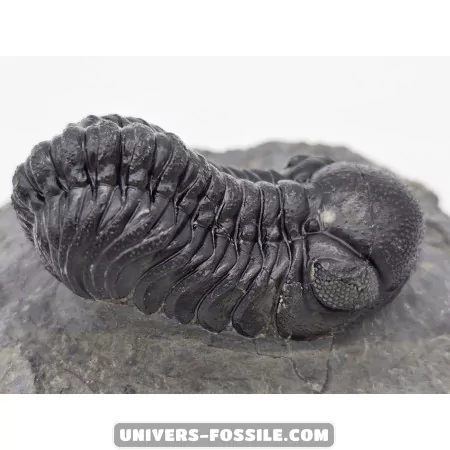Phacops Trilobites - Fossils from the Devonian Period

Phacops Trilobites
Phacops trilobites are a fascinating species of trilobites that thrived millions of years ago. Belonging to the class of arthropods, these prehistoric creatures are living fossils that have captivated the imagination of paleontologists and natural science enthusiasts.
Origin and Evolution
Phacops trilobites lived during the Paleozoic era, approximately 400 to 450 million years ago. They were widespread in the shallow seas that covered much of the Earth during that time. Their segmented body and hard exoskeleton helped them survive and thrive in a variety of marine habitats.
Anatomy
Phacops trilobites are characterized by their segmented external exoskeleton, which is divided into three distinct lobes. They also possessed large compound eyes, which were likely used to spot prey and detect predators in their environment. Their segmented appendages allowed them to move with agility on the seafloor.
Habitat and Lifestyle
Phacops trilobites were benthic creatures, meaning they primarily lived on the seafloor. They likely fed on organic debris and small organisms they found in the marine substrate. Their ability to move quickly allowed them to evade predators and...
Phacops Trilobites
Phacops trilobites, renowned for their intricate fossil remains, were ancient marine arthropods that roamed the seas during the Devonian period. These fascinating creatures possessed remarkable features and behaviors that continue to captivate researchers and enthusiasts alike.
Exploring Ancient Environments
Phacops trilobites thrived in the Devonian seas, utilizing their well-adapted structures to find food in their environment. These remarkable creatures left behind a wealth of fossils that provide a window into prehistoric marine ecosystems.
Fossils of Phacops
Fossils of Phacops trilobites are quite common in certain regions of the world, including North America and Europe. They are often found in sedimentary layers dating from the Devonian period, a geological era that spanned from 419 to 358 million years ago. The preserved remains of Phacops offer valuable insights to scientists about the biodiversity and evolution of ancient marine life.
Unraveling Ancient Mysteries
The study of Phacops trilobites sheds light on the intricate web of life that existed millions of years ago. These fossils reveal details about their anatomy, behavior, and ecological interactions, providing a glimpse into the rich history of Earth's oceans.
Conclusion: A Glimpse into the Past
Phacops trilobites are captivating creatures that thrived hundreds of millions of years ago in the ancient seas of the Earth. Their fossils offer valuable insights into prehistoric marine life, aiding in our understanding of the planet's geological history. The study of Phacops continues to intrigue scientists and enthusiasts of paleontology worldwide.
Whether it's their complex anatomy, intriguing lifestyle, or significance in understanding our geological past, Phacops trilobites continue to hold a lasting fascination for those interested in the ancient world around us.
